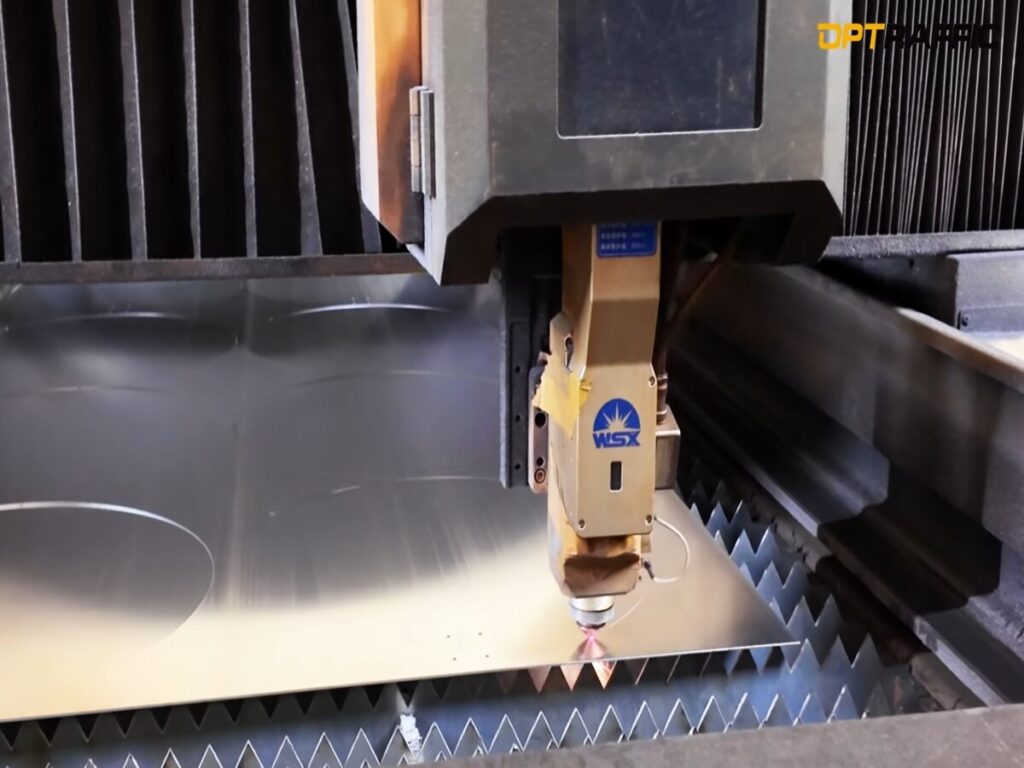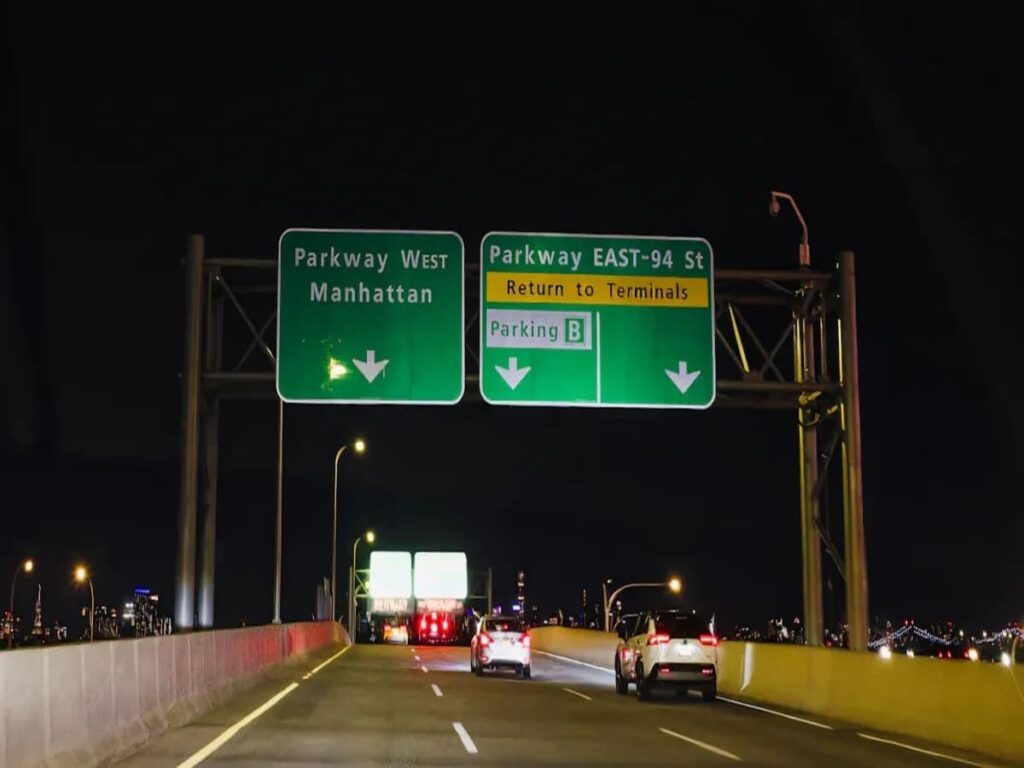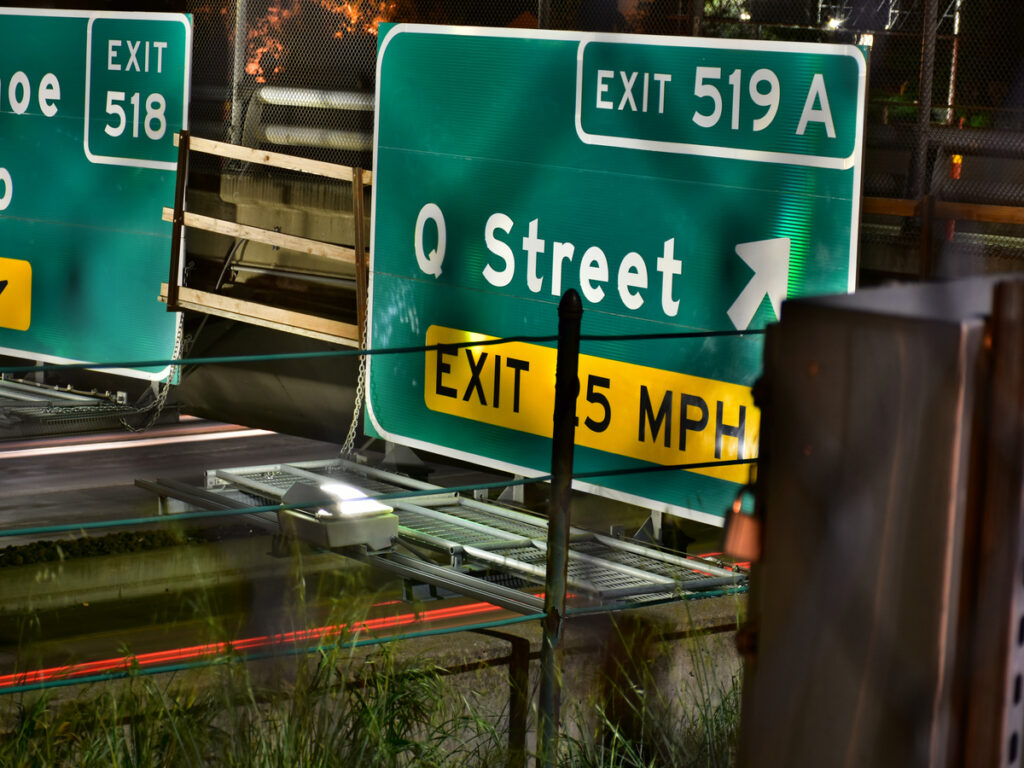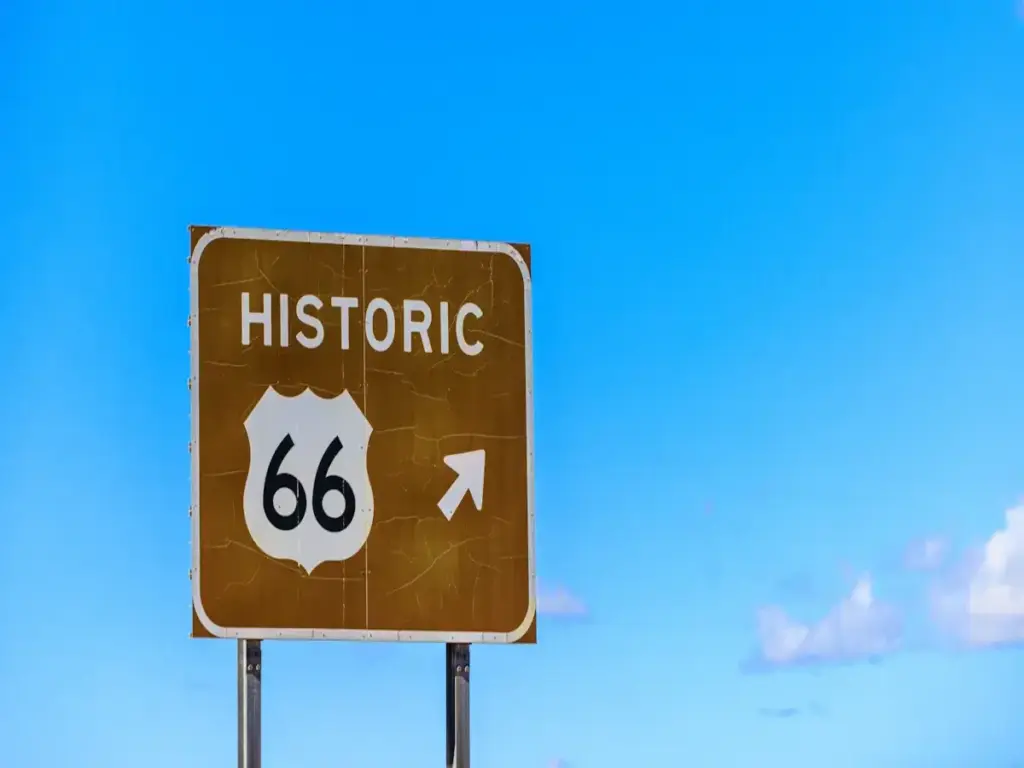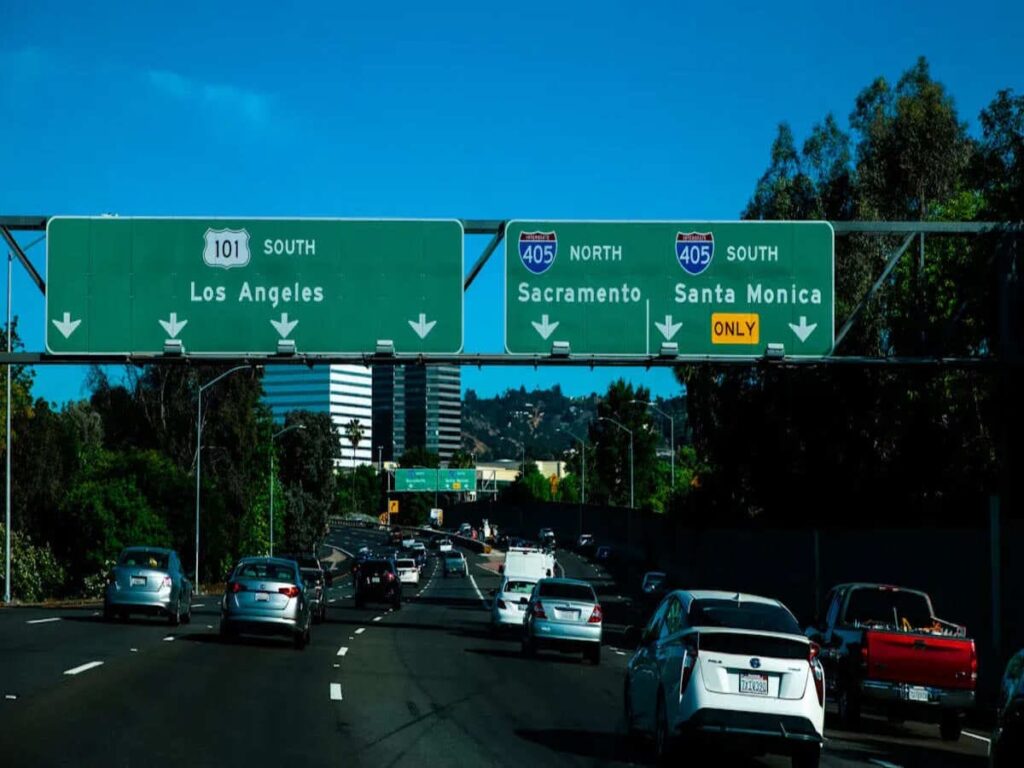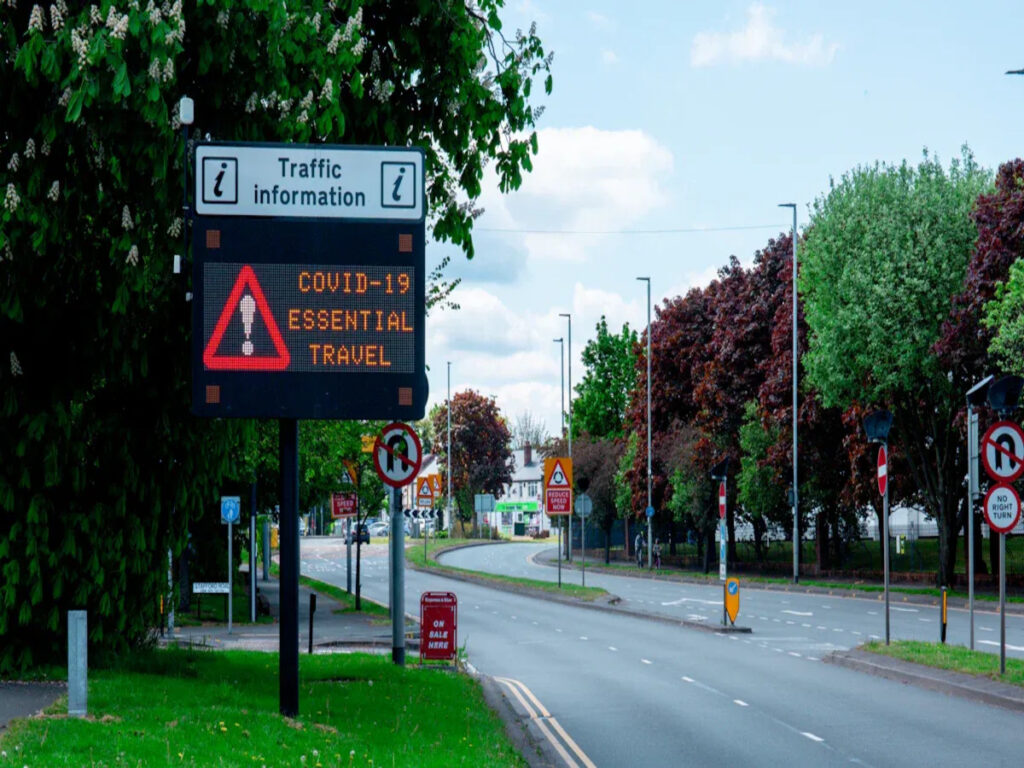
Avez-vous déjà vu que les panneaux routiers ont l'air plus gros sur l'autoroute que dans vos rues locales? Vous voyez ces changements tous les jours, Mais vous ne savez peut-être pas pourquoi ils sont importants. Les tailles de panneaux routiers au Royaume-Uni changent sur l'endroit où vous conduisez. Vitesse, Comment vous pouvez voir, et le type de route aident à vous assurer de voir les tailles de panneaux de route clairement et en toute sécurité.
À OPTRAFIC, nous comprenons comment la taille des panneaux affecte la sécurité et la conformité. C'est pourquoi nous proposons Panneaux de signalisation aux normes britanniques à vendre adapté aux différentes routes et zones de vitesse, aider les conducteurs à rester informés et protégés dans tous les environnements de conduite.
Classifications routières et conception des panneaux
Hiérarchie routière au Royaume-Uni
Le Royaume-Uni classe les routes en différents groupes. Chaque groupe a son propre travail et ses propres règles. Le tableau ci-dessous répertorie les principaux types de routes, ce qu'ils veulent dire, et qui fixe les règles:
| Classement des routes | Définition / Description | Base réglementaire ou gouvernementale |
|---|---|---|
| Autoroutes (M) | Ce sont de grandes routes pour les longs trajets entre les villes. Ils ont un 'M’ au début, comme M40. | Le gouvernement et le Règlement sur la signalisation routière 2002 fixer les règles. |
| Une route | Ce sont des routes principales avec un « A »’ au début, comme A40. Certaines sont appelées routes principales. Ceux-ci sont choisis par le gouvernement comme les meilleurs moyens de voyager entre des lieux importants.. | La loi est différente dans chaque pays. Le gouvernement et les autorités routières décident quelles routes sont prioritaires. |
| Routes B | Ces routes ne sont pas aussi importantes que les routes A. Ils ont un 'B’ au début, comme B1110. | Les zones locales décident comment utiliser ces routes. Ils font partie des numéros de route officiels. |
| Routes mineures (C, D, U) | Ce sont des routes locales gérées par les conseils locaux. 'U’ signifie non classé. On ne voit pas souvent ces chiffres sur les panneaux, mais ils sont parfois utilisés. | Ces routes sont à usage local et ne sont pas toujours indiquées sur les panneaux.. |
| Itinéraires principaux | Ce sont les meilleures routes pour traverser une zone, sauf autoroutes. En Ecosse, ils correspondent au réseau routier national. | Le secrétaire d'État ou les gouvernements locaux choisissent ces routes. Ils sont pris en charge par le ministère des Transports et d'autres groupes gouvernementaux. |
| Voies doubles | Ces routes ont deux côtés, avec une barrière au milieu. | Le gouvernement fixe les règles pour ces routes. |
| Autoroutes | Ce sont des routes de grande qualité construites depuis 2015. On ne sait pas comment cela change les règles. | Le gouvernement a fait ce nouveau type de route. |
Chaque type de route a ses propres règles. Ensemble, ils composent le Le système routier du Royaume-Uni.
Impact sur la taille des panneaux routiers
La taille des panneaux routiers change en raison de la hiérarchie des routes. Le type de route, à quelle vitesse vont les voitures, et combien de voitures l'utilisent, tout cela compte. Voici quelques façons dont le type de route modifie la conception des panneaux:
- Le type de carrefour change là où vont les panneaux.
- Les règles de sécurité aident à décider où placer les panneaux. Cela donne aux conducteurs le temps de réagir.
- Les panneaux de direction utilisent des couleurs différentes. Le bleu est pour l'autoroute, le vert est pour les routes primaires A, et le blanc est pour les routes locales. Ces couleurs vous aident à connaître rapidement le type de route.
- Les panneaux sont placés de manière à ce que les conducteurs les voient au bon moment.
- Le nombre de lieux indiqués sur un panneau correspond à l'importance de la route. Les panneaux d'autoroute indiquent les grandes places. Les panneaux de signalisation locaux montrent plus de détails.
- La taille des panneaux et les lettres sont choisies pour que vous puissiez les lire à la bonne vitesse.
- Les plantes et les arbres ne doivent pas bloquer les panneaux. Cela les rend faciles à voir.
Sur une autoroute, les panneaux sont grands et faciles à lire. Ils utilisent de grosses lettres et des dessins simples. Les règles de signalisation autoroutière garantissent une bonne visibilité, Même la nuit. De nombreux panneaux d'autoroute sont suspendus au-dessus de la route pour que tout le monde puisse les voir. Sur les routes A et les routes B, les panneaux sont plus petits mais toujours clairs. Dans les rues de la ville, les panneaux sont encore plus petits et s'intègrent dans des endroits très fréquentés. Ils ne bloquent pas les trottoirs ni les vues. Ces règles garantissent que la taille des panneaux s'adapte à chaque type de route.. Cela assure la sécurité des routes et facilite la circulation.. Local rules and uk road markings also help you follow signs every day. You use these signs and markings to find your way, whether you are on a motorway or a local street.
Key Factors Affecting Road Sign Sizes
Speed and Visibility
Speed plays a big part in how you see road signs. When you drive on a motorway, you travel much faster than on a city street. You need to spot signs early and react quickly. The faster you go, the bigger the sign must be. This helps you read the message before you pass it. Si vous manquez un signe, you could make a wrong turn or even cause accidents. That is why safety is always the top goal.
You will notice that speed limits change from one road to another. Sur une autoroute, the limit can reach 70 mph. On a city street, the limit might be 30 mph. Each limit means you need a different sign size. Le tableau ci-dessous montre comment la taille des panneaux change en fonction de la vitesse et du type de route.:
| Type de route / Limitation de vitesse | Taille minimale du panneau de terminal (mm) | Taille minimale du panneau de répéteur (mm) |
|---|---|---|
| Chaussée unique, limite de vitesse nationale | 600 | 450 |
| Route à quatre voies, limite de vitesse nationale | 900 | 450 |
| Route à quatre voies, 60 mph | 600 | 450 |
| 50 mph et moins (toutes les routes) | 600 | 300 |
Vous devez également réfléchir à la distance à laquelle vous pouvez voir un panneau.. The faster you go, plus la distance de visualisation doit être longue. Par exemple, sur une autoroute, il faut voir un panneau beaucoup plus loin que sur une route rurale tranquille. Cela vous laisse le temps de ralentir ou de changer de voie en toute sécurité. Le tableau ci-dessous montre comment la visibilité change avec la vitesse:
| Contexte de vitesse | Largeur de la ligne d'avertissement | Considérations relatives à la distance de visibilité | Remarques |
|---|---|---|---|
| Jusqu'aux vitesses intermédiaires (Par exemple, 45 mph) | 100 mm ou 150 mm | 120–195 m | Utilisez des lignes plus larges pour une meilleure visibilité |
| 70 mph autoroutes et autoroutes | 150 mm | Des distances plus longues sont nécessaires | Des lignes plus larges aident sur les routes rapides |
Vous verrez que des lignes plus larges et des panneaux plus grands vous aident à repérer les avertissements plus tôt.. This is a key part of safety standards in the UK. If you drive on a motorway, you rely on these safety measures to avoid accidents and keep traffic flow smooth.
Traffic and Environment
Traffic flow and the road environment also shape sign size. Busy roads with lots of cars need bigger, clearer signs. Sur une autoroute, you often see huge blue signs above the lanes. These signs help you pick the right lane and follow the correct route. Si les signes sont trop petits, you might miss your exit or cause confusion, ce qui peut conduire à des accidents.
Dans les villes, you see smaller signs. Streets are narrow, and many people walk on the pavements. Signs must not block the way or spoil the view. You still need to see the limits and follow the rules, but the signs fit the space. Dans les zones rurales, hedges and trees can hide signs. Designers raise the signs higher or use larger panels to keep them visible. Cela vous aide à repérer les limites et les avertissements à temps, même si la route tourne ou descend.
L’éclairage compte aussi. Sur les routes éclairées, vous ne verrez peut-être pas autant de signes de répétition pour 30 limites de mph. Sur les routes non éclairées, des répétiteurs vous rappellent la limitation de vitesse à intervalles réguliers. Cela vous tient informé et soutient la sécurité, surtout la nuit.
Des limitations de vitesse variables apparaissent sur certaines autoroutes. Ces panneaux numériques modifient la limite en fonction du flux de circulation ou de la météo.. On les voit sur les portiques au-dessus de la route. Ils utilisent des lumières vives et de grands nombres pour que vous ne puissiez pas les manquer, Même par mauvais temps.
Note: If you drive on a motorway, vous dépendez de panneaux clairs pour assurer votre sécurité et vous aider à respecter les limites. Une bonne conception des panneaux réduit les accidents et respecte les normes de sécurité dans tout le Royaume-Uni.
Vous pouvez voir que chaque détail, de la taille des lettres à la hauteur du signe, liens vers la sécurité. La bonne taille de panneau vous aide à respecter les limites, éviter les accidents, et maintenir la fluidité du trafic. Lorsque vous comprenez ces facteurs, vous voyez pourquoi la taille des panneaux change des rues de la ville aux autoroutes et routes rurales.
Rues de la ville et tailles des panneaux de signalisation
Dimensions typiques des panneaux urbains
Lorsque vous marchez ou conduisez dans les rues de la ville, vous remarquez que les panneaux de signalisation semblent plus petits que ceux des autoroutes. En effet, vous voyagez à des vitesses inférieures et disposez de moins de distance pour lire chaque panneau.. La plupart des panneaux circulaires dans les zones urbaines mesurent 450 mm, 600 mm, ou 750 mm de diamètre. Les triangles de signalisation ont généralement une longueur de côté de 600 mm. Les plaques de stationnement et de restriction sont souvent disponibles dans des tailles telles que 400 × 600 mm ou 600 × 800 mm. La hauteur x, quelle est la hauteur des lettres principales, est souvent 50 mm dans les rues de la ville. Cette taille fonctionne bien car vous vous déplacez lentement et pouvez voir les panneaux de près. Vous constatez que ces dimensions aident à garder les panneaux clairs sans prendre trop de place.
Montage et placement
Vous voyez de nombreux panneaux installés le long des trottoirs et aux coins des rues. Dans les zones occupées, les concepteurs doivent penser à la fois aux conducteurs et aux personnes qui marchent. Selon la réglementation britannique, le bord inférieur d'un panneau doit se situer entre 900 mm et 1500 mm au-dessus de la route. Sur les trottoirs, les panneaux doivent laisser suffisamment d'espace pour que les gens puissent marcher en dessous. La hauteur minimale pour le passage des piétons est 2100 mm, mais 2300 mm c'est encore mieux. Cela permet de garder les panneaux à l'écart et en toute sécurité pour tout le monde.. Dans les rues étroites ou les zones partagées, vous pourriez apercevoir des panneaux plus petits ou des supports de montage spéciaux. Ces changements aident les panneaux à s'adapter aux espaces restreints et à éviter de bloquer les chemins.. Vous voyez également des panneaux placés à des angles afin que les conducteurs et les piétons puissent les lire facilement.. Good placement and the right road sign sizes make city streets safer and easier to navigate.
Motorway Sign Size Standards
Motorway Sign Features
When you drive on a motorway, you see that sthe igns are much bigger than city street signs. This is because you go fast and need to read signs quickly from far away. Le UK Traffic Signs Manual says motorway signs must have a 300 mm x-height. This means the main lowercase letters are 300 mm de haut. You can read them easily, even when moving fast. The tile height is double the x-height, so it is 600 mm. Designers use a 75 mm stroke width to make letters bold and clear. These sizes help you spot directions and warnings in time.
Colour coding is important for motorway signs. Green backgrounds show guidance and direction. Blue is for services. Orange is for temporary works. All parts of the sign, sauf le noir, must be reflectorized. Cela vous aide à voir les panneaux la nuit ou par mauvais temps. Le Royaume-Uni a des règles strictes en matière de réflectivité, pour que les panneaux restent lumineux à grande vitesse.
| Classe de réflectivité | Gamme de rétroréflexité (CD / LX / M²) | Utilisation typique des panneaux d'autoroute | Plage de visibilité | Durabilité |
|---|---|---|---|---|
| RA1 (Grade d'ingénierie) | 50–90 | Signes temporaires, Routes urbaines à basse vitesse | ~150 mètres | 3–5 ans |
| RA2 (Prismatique de haute intensité) | 100–250 | Signalisation réglementaire permanente, autoroutes, y compris les autoroutes | ~250 mètres | 7–10 ans |
| RA3 (Grade de diamant ou VIP) | >300 | Autoroutes, tunnels, grands panneaux de guidage, panneaux d'avertissement critiques sur les autoroutes | >300 mètres | 10–12+ ans |
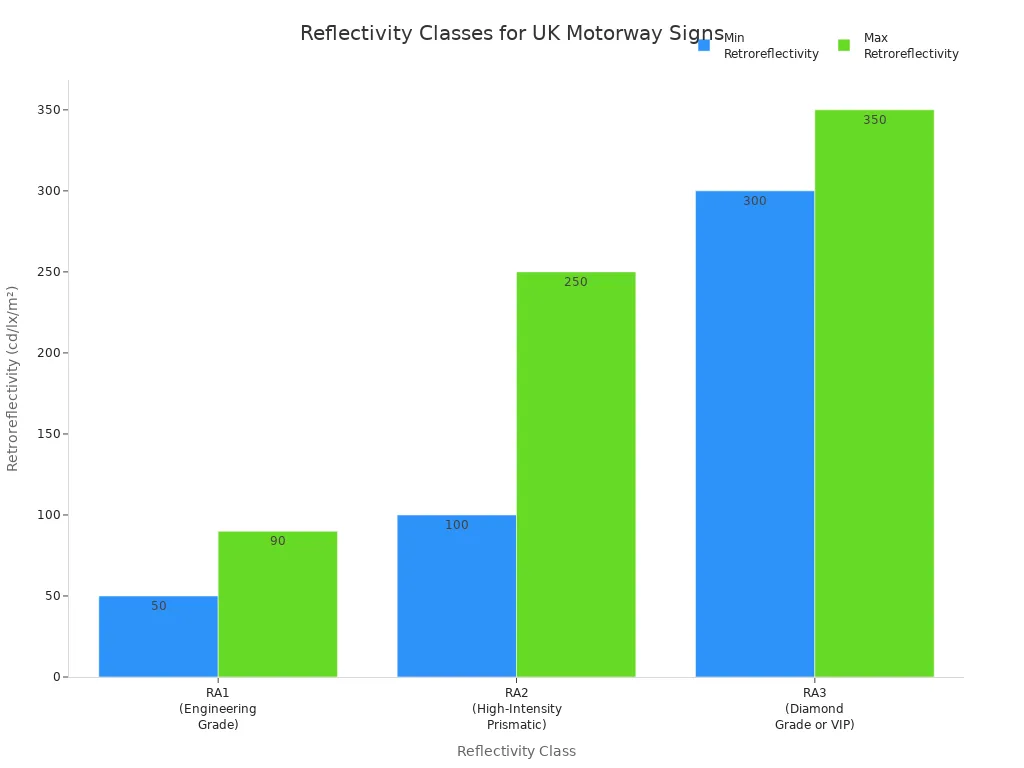
Conseil: Une réflectivité élevée et de grandes lettres vous aident à voir les signes tôt, Même dans l'obscurité ou la pluie.
Montage et conformité
On voit souvent des panneaux d'autoroute sur de grands portiques ou des bras en porte-à-faux au-dessus des voies.. Cela garantit que chaque conducteur peut voir le panneau, peu importe la voie qu'ils utilisent. Signes de messages variables sur les cantilevers vous donnent des mises à jour en temps réel sur la circulation ou les dangers. Le ministère des Transports a des règles strictes pour ces structures. La BD 51/98 la norme explique comment concevoir et installer des portiques et des cantilevers. Cela les maintient en sécurité et solides par tous les temps. Les conceptions d'autoroutes intelligentes suivent des conseils supplémentaires pour les nouvelles technologies et les besoins de trafic.
Les règles autoroutières stipulent que tous les panneaux routiers doivent répondre à ces normes de conception et de sécurité.. Quand tu vois ces gros, signes clairs, vous savez qu'ils suivent des règles qui assurent votre sécurité et celle des autres. Bon montage, codage couleur, et la réflectivité travaillent ensemble pour rendre les déplacements sur autoroute plus sûrs et plus faciles. La taille des panneaux routiers sur les autoroutes établit la norme en matière de visibilité et de sécurité dans tout le Royaume-Uni..
Routes rurales et dimensionnement des panneaux
Tailles courantes des panneaux ruraux
Lorsque vous voyagez sur des routes rurales, vous remarquez que la taille des panneaux routiers change en fonction de la vitesse et du tracé de la route. Les routes rurales ont souvent des limites de vitesse plus élevées que les rues des villes, il faut donc des panneaux plus grands pour les lire à distance. La hauteur x, quelle est la hauteur des lettres principales, augmente à mesure que la vitesse augmente. Par exemple, un 50 mm x-hauteur fonctionne bien pour des vitesses allant jusqu'à 30 mph. Sur des routes rurales plus rapides, vous voyez des hauteurs x de 150 mm ou même 200 mm pour des vitesses allant jusqu'à 70 mph. Certaines voies étroites utilisent un 40 mm x-height, surtout pour les panneaux spéciaux comme “MALADIE ANIMALE”.
Voici un tableau montrant les tailles et hauteurs d'x typiques des panneaux pour les routes rurales.:
| Limitation de vitesse (mph) | Hauteur x typique (mm) | Taille de signe commune (mm) |
|---|---|---|
| Jusqu'à 30 | 40–50 | 600–750 |
| 40–50 | 75–100 | 750–900 |
| 60–70 | 150–200 | 900–1200 |
Vous pouvez le constater à mesure que la vitesse augmente, la hauteur x et la taille globale du signe s'agrandissent. Cela vous aide à repérer les avertissements et les directions à temps.
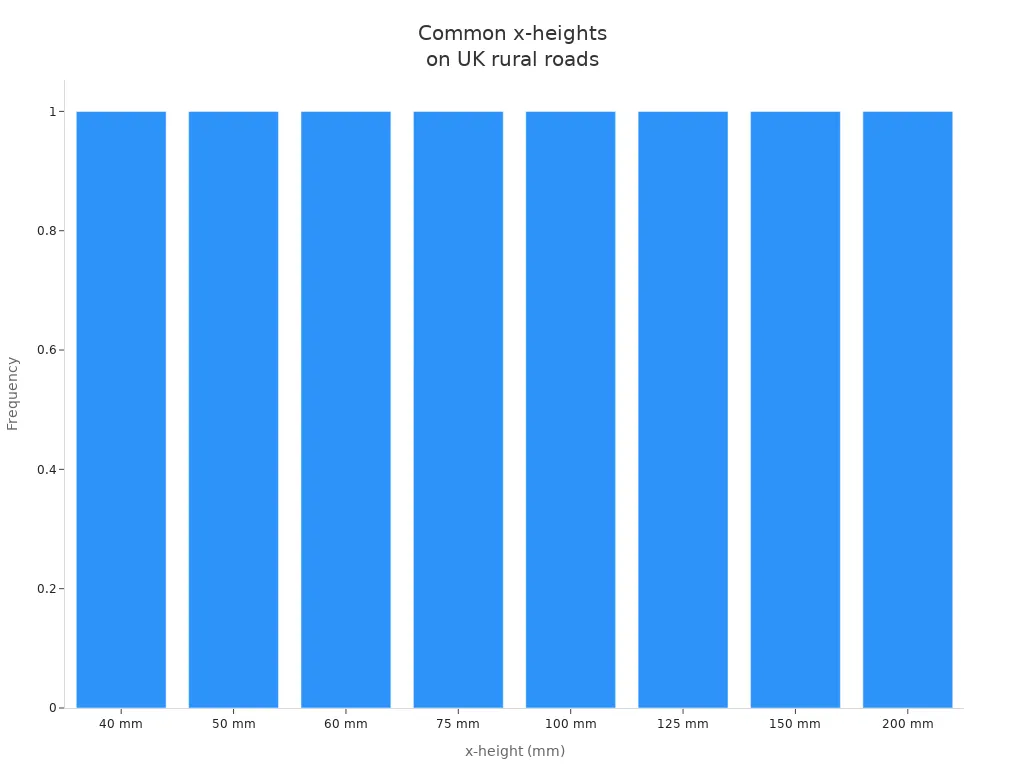
Adaptation aux conditions locales
Les routes rurales sont souvent sinueuses, avec haies et arbres proches de la lisière. Ces fonctionnalités peuvent masquer les signes ou les rendre difficiles à voir. Les concepteurs doivent placer des panneaux là où vous pouvez les repérer avant un virage ou un carrefour.. Parfois, ils augmentent la hauteur de montage pour maintenir les panneaux au-dessus des herbes hautes ou de la neige. Vous pourriez voir des panneaux plus hauts que d'habitude, surtout là où les haies sont épaisses.
D'autres défis incluent:
- Les virages serrés nécessitent la mise en place de panneaux afin que vous ayez suffisamment de temps pour réagir.
- Les panneaux ne doivent pas être placés là où une voiture pourrait les heurter dans un virage..
- Dans les zones venteuses, les panneaux ont besoin de poteaux solides pour les empêcher de tomber.
- Si un panneau est plus haut que 7 mètres, il nécessite une approbation spéciale.
Conseil: Quand vous conduisez sur des routes rurales, attends toujours les signes devant toi, surtout près des virages ou là où des haies pourraient bloquer votre vue. Un placement approprié des panneaux assure votre sécurité et vous aide à faire les bons choix sur les routes de campagne..
Comparaison des tailles de panneaux routiers
Ville vs autoroute vs rural
Lorsque vous voyagez sur des routes différentes, vous remarquez un changement dans la taille des panneaux. Le tableau ci-dessous montre comment la taille du signe, réflectivité, et les supports sont différents pour chaque type de route:
| Type de route | Spécifications de taille de panneau | Exigences de réflectivité | Exigences du support | Raisonnement / Contexte |
|---|---|---|---|---|
| Routes rurales | Panneaux plus grands avec des tolérances de taille précises | Surfaces réfléchissantes de haute qualité obligatoires | Fort, robuste, rust-resistant brackets | Lack of street lighting and higher speeds require enhanced visibility and durable mounting. |
| Urbain (Ville) | Plus petit, simpler signs to fit limited space | Reflectivity less emphasised | Léger, tamper-proof brackets | Space constraints and need to reduce clutter; signs must be quickly comprehensible to drivers. |
| Autoroute | Larger signs similar to rural roads | High reflectivity required | Strong brackets to support bigger signs | High speeds demand longer stopping and overtaking sight distances, necessitating bigger, signes visibles. |
Dans les rues de la ville, signs are smaller because cars go slower and space is tight. On the motorway, signs are the biggest. They use strong brackets and are very reflective to meet safety rules. Rural roads also have large signs, but they must be tough and easy to see because there are fewer lights and more bends.
Practical Implications
Ces différences vous aident à chaque fois que vous conduisez. On the motorway, grand, des panneaux lumineux vous aident à voir rapidement les limites et les directions, Même par mauvais temps. Cela réduit les chances d'accidents et maintient bien la circulation. Dans les villes, de petits panneaux arrêtent l'encombrement et maintiennent les trottoirs ouverts aux piétons. Tu vois toujours les règles, mais les panneaux s'adaptent aux rues animées.
Les planificateurs choisissent la taille des panneaux routiers pour assurer votre sécurité et respecter la loi. Si un panneau d'autoroute est trop petit, les conducteurs peuvent manquer des avertissements ou des limites, ce qui pourrait provoquer des crashs. On rural roads, des supports solides et des panneaux réfléchissants garantissent que vous pouvez les voir, Même la nuit. Des études montrent que plus, des signes plus lumineux vous aident à comprendre les messages plus rapidement. Cela signifie que vous réagissez rapidement et évitez les erreurs.
Souviens-toi: La bonne taille de panneau n’est pas qu’une question de règles. Cela vous protège, soutient la sécurité, et aide les routes à bien fonctionner. Quand tu vois le bon panneau au bon endroit, vous savez que le système vous aide et maintient la circulation fluide.
Vous remarquez que les tailles des panneaux routiers au Royaume-Uni sont différentes pour chaque type de route.. En effet, il existe des règles strictes en matière de sécurité et de visibilité..
Pour comprendre comment ces règles affectent vos projets et vos décisions d’achat, Lisez notre blog: Un guide complet des tailles de panneaux de trafic britanniques pour les acheteurs et les entrepreneurs.
FAQ
Quelle est la hauteur x sur un panneau routier?
Vous voyez la hauteur x comme la hauteur des principales lettres minuscules d'un panneau.. Cette taille vous aide à lire le message rapidement. Des hauteurs d'x plus grandes signifient que vous pouvez repérer les signes de plus loin, ce qui est important sur les routes plus rapides.
Pourquoi les panneaux d'autoroute paraissent-ils tellement plus grands?
Vous conduisez plus vite sur les autoroutes. Vous devez lire les panneaux à longue distance. Les concepteurs utilisent des panneaux et des lettres plus grands pour que vous ayez suffisamment de temps pour réagir. De grands panneaux vous aident également à voir les directions par mauvais temps ou la nuit.
Les routes rurales utilisent-elles toujours des panneaux plus grands que les rues des villes?
You often find larger signs on rural roads because you travel faster and need more time to see warnings. City streets use smaller signs to fit tight spaces and avoid blocking pavements. Each road type uses the size that keeps you safest.
How do sign designers choose the right size?
Designers look at the road type, Limitation de vitesse, and how far away you need to see the sign. They use official tables and rules. You can trust that each sign follows strict standards for safety and visibility.
Can signs be too big for city areas?
Oui, signs that are too large can block pavements or spoil the look of a street. You see smaller, well-placed signs in cities. This keeps paths clear and helps everyone move safely.
Conseil: Always look for signs that match the road you are on. La bonne taille vous aide à rester en sécurité et à suivre les règles.


